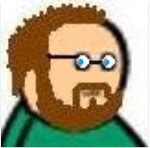April A-to-Z: must-read books
The Hobbit (1937)
By J. R. R. Tolkien
(1892-1973) England
I can’t imagine there’s anything left to say about Tolkien’s epic saga,
comprised of The Hobbit, and the six books (traditionally published in pairs)
which make up The Lord of the Rings story.
There is something timelessly wholesome in reading Tolkien. If R. L.
Stevenson can be regarded a grandfather of pirate lore then Tolkien is
certainly the grand master of
fantasy. His vision of Elven, Dwarven and Hobbit cultures have ever remained
the staple interpretations; a mythology model from which thousands of subsequent
authors begin.
There is a marvelous magical potential inherent in these works as a whole:
One reads The Hobbit; a perfect simple adventure quest story, as a pre-teen or young teen,
and then Lord of the Rings; complex and multi-themed, as a young adult. They
are then forever more re-readable and forever unite the reader’s childhood and
adult perspectives. Let’s face it, there is a childish component to fantasy and
imagination (however noble they may be), and like Bradbury, Tolkien is a valuable
agent to adults endeavoring to keep that childhood link alive.
The Hobbit is a must-read for any young person (or young-at-heart) with
any love at all for fantasy-adventure, or who has yet to discover that love!
A passage:
“Moon-letters are
rune-letters, but you cannot see them,” said Elrond, “not when you look
straight at them. They can only be seen when the moon shines behind them, and
what is more, with the more cunning sort it must be a moon of the same shape
and season as the day when they were written. The dwarves invented them and
wrote them with silver pens, as your friends could tell you. These must have
been written on a mid-summer’s eve , in a crescent moon, a long while ago.”
“What do they say,” asked
Gandalf and Thorin together, a bit vexed perhaps that even Elrond should have
found this out first, though really there had not been a chance before, and
there would not have been another until goodness knows when.
“Stand by the gray stone when
the thrush knocks,” read Elrond, “and the setting sun with the last light of
Durin’s Day will shine upon the key-hole.”
“Durin, Durin!” said Thorin. “He
was the father of the fathers of the first race of Dwarves, the Long-Beards, and
my first ancestor: I am his heir.”
“Then what is Durin’s Day?”
asked Elrond.
“The first day of the Dwarves’
new year,” said Thorin, “is as all should know the first day of the last moon
of Autumn on the threshold of Winter. We still call it Durin’s Day when the
last moon of Autumn and the sun are in the sky together. But this will not help
us much, I fear, for it passes our skill in these days to guess when such a
time will come again.”
“That remains to be seen,”
said Gandalf. “Is there any more writing?”
“None
to be seen by this moon,” said Elrond, and he gave the map back to Thorin; and
then they went down to the water to see the elves dance and sing upon the midsummer’s
eve.








































1 comment:
Visiting from the #AtoZChallenge minion group, AJ's wHooligans!
Excellent choice for the letter "H". Would you believe I had read none of the series before seeing LOTR back in the day?
Post a Comment